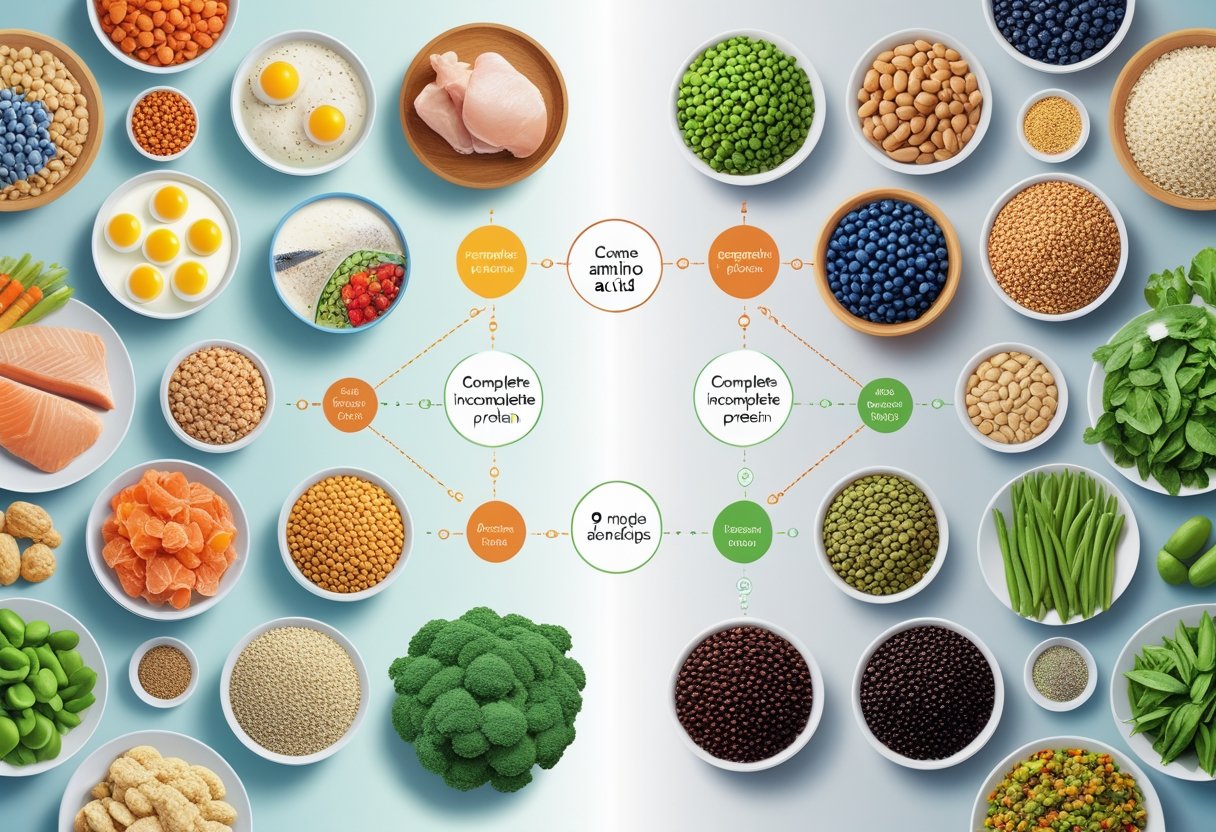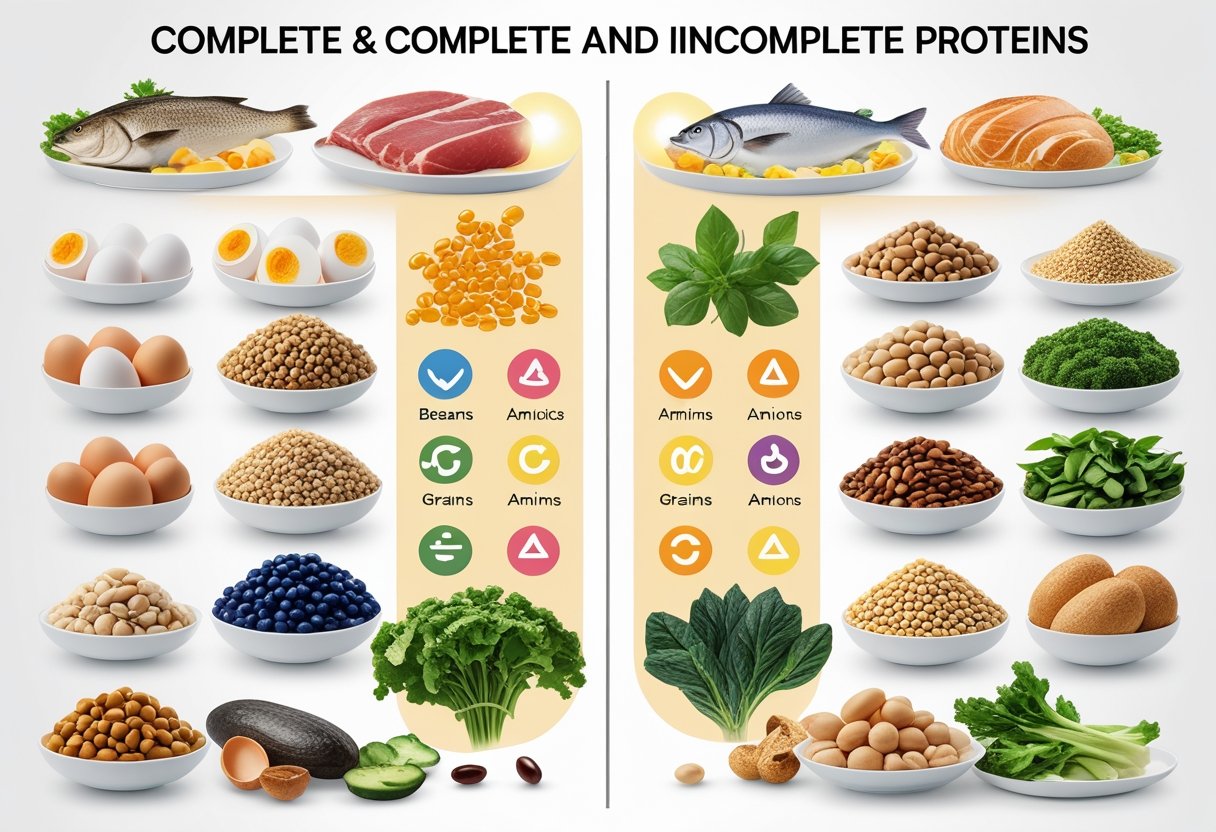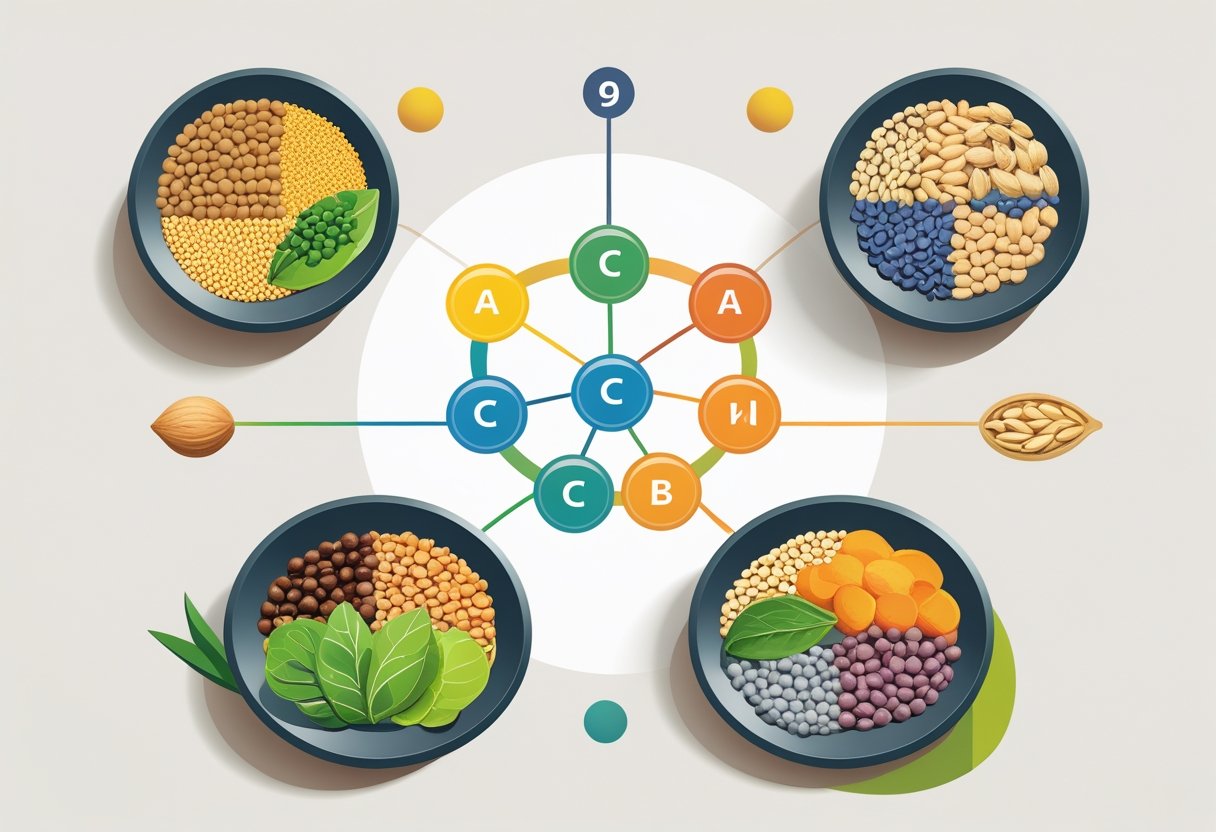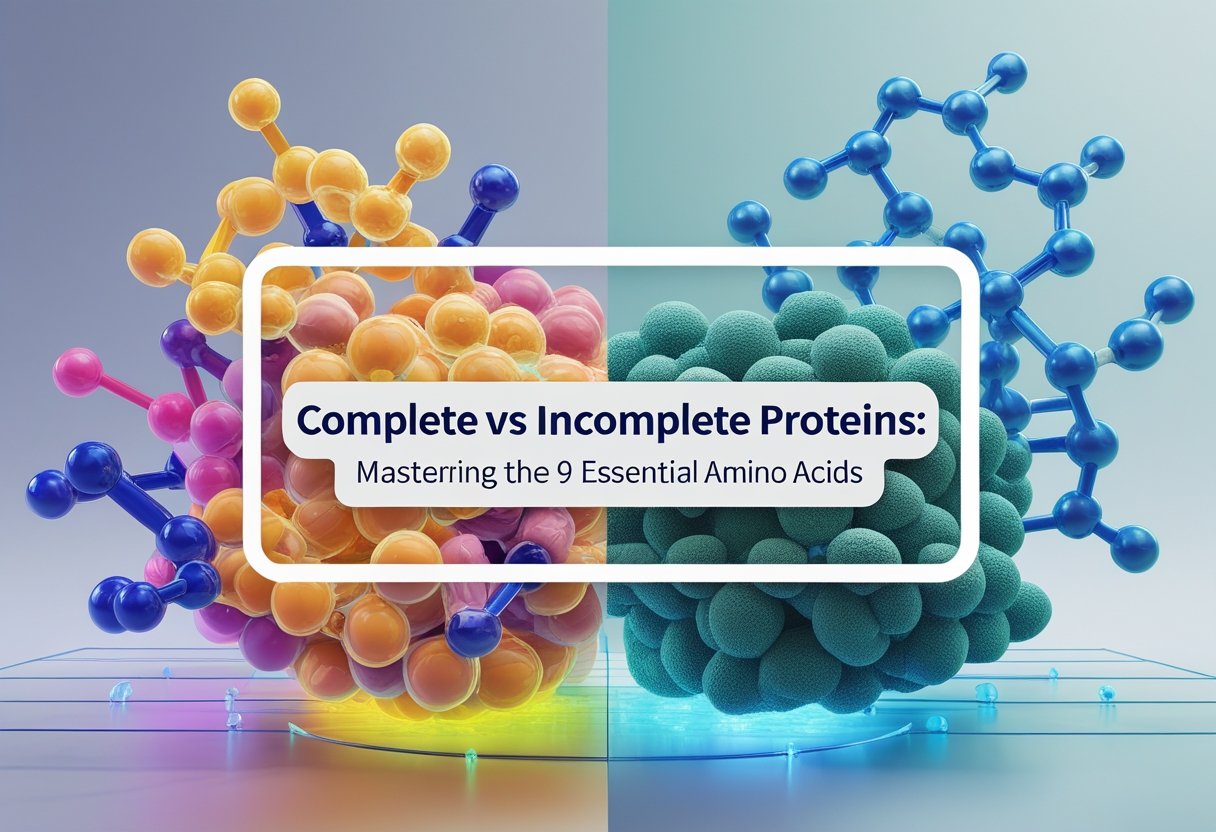Proteins are a key part of nutrition; not all proteins are the same. Complete proteins give your body all nine essential amino acids it cannot make alone, while incomplete proteins are missing at least one of these building blocks. Understanding the difference can help people make better choices about what they eat.

Complete proteins are usually found in animal products like fish, poultry, eggs, and dairy. Some plant foods, such as quinoa and soy, also provide complete proteins. Many other plant foods, like beans and grains, are incomplete, but eating a variety of them can cover all the needed amino acids over time.
Choosing the right mix of protein sources is important for balanced nutrition. People who do not eat animal products can still get enough essential amino acids by combining different plant foods or using supplements when needed. Learning about complete and incomplete proteins can help anyone make smarter meal choices.
Key Takeaways
- Complete proteins offer all nine essential amino acids needed by the body.
- Many plant foods are incomplete proteins but can be combined for full benefits.
- Choosing the right protein sources improves nutrition and fills amino acid gaps.
Understanding Proteins and Amino Acids
Proteins are made of chains of amino acids and play major roles in the body, such as building tissues and supporting vital processes. Essential and non-essential amino acids are both important for health, growth, and metabolism.
Structure and Function of Proteins
Proteins are long molecules built from smaller units called amino acids. There are 20 different amino acids that can link in different orders to make unique protein chains.
These chains fold into complex shapes. The shape decides what job the protein does. Some proteins help build muscles and organs, while others act as enzymes that speed up chemical reactions.
Proteins also support the immune system and transport nutrients. They are a key macronutrient, meaning the body needs them in large amounts. Without enough protein, cells cannot grow, repair, or function well.
Types of Amino Acids: Essential and Non-Essential
Amino acids can be grouped into essential and non-essential categories.
Essential amino acids (histidine, isoleucine, leucine, lysine, methionine, phenylalanine, threonine, tryptophan, and valine) cannot be made by the body. People must get them from food. Foods with all essential amino acids are called complete proteins.
Non-essential amino acids can be made by the body itself. While all 20 amino acids are needed, only the 9 essential ones have to come from the diet. Both kinds are used to create proteins needed for life.
Role in Human Health
Proteins are important for building muscles, bones, skin, and blood. During childhood, protein supports proper growth and development.
Amino acids are used to make hormones that control body functions, such as growth and mood. They are also important in metabolism, the process that changes food into energy.
Eating enough protein helps the body repair tissues after an injury and fight off infections. Consuming all essential amino acids is needed to keep metabolism, immunity, and growth working at their best. Incomplete protein intake can lead to health issues, especially in children and teens.
What Makes a Protein Complete or Incomplete
Proteins are made up of smaller parts called amino acids. Some proteins have all the amino acids the body needs, while others are missing one or more.
Definition of Complete Proteins
A complete protein contains all nine essential amino acids. These essential amino acids are not made by the human body. They must be taken in through food.
Animal-based foods like meat, fish, eggs, and dairy are common sources of complete proteins. Some plant foods, like soy and quinoa, also provide all the essential amino acids.
Complete proteins are important for muscle growth, tissue repair, and overall health. When a protein food is called “complete,” it means it has a balanced amount of all the nine essential amino acids. For more on this, visit this overview on complete proteins.
Definition of Incomplete Proteins
An incomplete protein is missing one or more of the nine essential amino acids. Most plant-based protein sources, such as beans, nuts, seeds, and whole grains, fall into this group.
Eating only incomplete proteins over time can make it harder for the body to build new proteins needed for different jobs. However, eating a mix of various plant foods throughout the day can still provide enough essential amino acids.
It isn’t necessary to combine these foods in a single meal, but variety is key. For example, rice is low in lysine but high in methionine, while beans are high in lysine but low in methionine. By consuming both during the day, a person can get all essential amino acids. Read about complete vs. incomplete proteins for a simple explanation.
The Importance of the 9 Essential Amino Acids
The nine essential amino acids are: lysine, methionine, leucine, histidine, isoleucine, phenylalanine, threonine, tryptophan, and valine. Each one helps the body with different important tasks, such as building muscle, repairing tissues, and making hormones.
A lack of any essential amino acid can slow down protein synthesis and affect health. The body does not store excess amino acids, so they must be taken in regularly.
Complete proteins offer all nine at once, while incomplete proteins require careful meal planning to fill in any missing amino acids. This makes foods rich in complete proteins useful for those wanting to easily meet their needs, but with the right diet, all essential amino acids can come from plant sources. Learn why these amino acids matter.
Sources of Complete Proteins
Complete proteins contain all nine essential amino acids in the right amounts. People can get these amino acids from both animal-based and some plant-based foods.
Animal-Based Complete Protein Sources
Animal-based protein sources offer complete proteins. This means they supply every essential amino acid in amounts the body needs. Meat such as beef, pork, and lamb are widely eaten and are reliable sources.
Poultry like chicken and turkey are also rich in complete protein. Many people reach for fish such as salmon, tuna, and cod, which offer lean protein along with important fats.
Eggs are notable because they contain high-quality, easily absorbed protein. Many nutrition experts consider eggs one of the best sources for all essential amino acids.
Dairy products like milk, cheese, and yogurt also contain complete animal protein. For example, Greek yogurt has a high protein content per serving. Animal products tend to have more complete proteins than most plant foods, making them a practical option for people who eat them.
A table of common animal-based complete protein sources:
| Food | Protein Content (per 100g) |
|---|---|
| Chicken | 27g |
| Salmon | 20g |
| Eggs | 13g |
| Milk | 3g |
| Greek Yogurt | 10g |
Learn more about complete protein in animal foods at Verywell Health.
Plant-Based Complete Protein Sources
Some plant-based protein sources also provide all nine essential amino acids. Soy products, including tofu, tempeh, and edamame, are the most well-known plant sources of complete protein.
Quinoa is another good example. It is a seed that people cook and eat like a grain, but it supplies complete protein in every serving. Hemp seeds have all essential amino acids and are easy to add to yogurt, cereal, or salads.
Chia seeds contain complete protein, but the amount per serving is small compared to animal foods or soy. Plant-based eaters often include a variety of these foods to help meet their protein needs.
A list of common plant-based complete protein sources:
- Soy (tofu, tempeh, edamame)
- Quinoa
- Hemp seeds
- Chia seeds
- Amaranth
Plant-based complete proteins may be lower in total protein than most animal products, but they are valuable choices for anyone looking to avoid animal protein. Read more about what makes a protein complete at the Cleveland Clinic.
Sources of Incomplete Proteins

Many foods, especially plant-based options, provide protein but lack one or more of the nine essential amino acids. For those who follow a plant-based diet or are strict vegetarians, understanding these foods can help balance their nutrient intake.
Common Plant-Based Incomplete Proteins
Beans, nuts, and seeds are popular choices for those seeking protein from plants, but most of them are considered incomplete. This means they do not offer all the essential amino acids in the right amounts.
Examples include black beans, peanuts, almonds, sunflower seeds, and walnuts. Lentils and chickpeas also fall into this category. While these foods are packed with protein, fiber, and other nutrients, they lack certain essential amino acids like methionine or lysine.
Below is a list of commonly eaten incomplete protein sources:
- Peanuts
- Almonds
- Sunflower seeds
- Lentils
- Chickpeas
- Walnuts
Those eating mainly plant sources should consider mixing and matching different types throughout the day. This helps ensure they get enough of all essential amino acids over time, even though most single foods do not provide a complete set. Find more about complete versus incomplete proteins at Cleveland Clinic.
Grains, Legumes, and Vegetables
Grains, such as wheat, rice, oats, and corn, are important sources of protein in many diets. However, on their own, these are often considered incomplete proteins because they lack lysine.
Legumes, like beans and peas, have lots of protein but may lack methionine. Vegetables, such as spinach and broccoli, offer protein in smaller amounts, but they also fall short of providing all essential amino acids in one food. Incomplete protein foods can still be healthy building blocks in a plant-based meal plan.
Combining foods, such as eating beans and rice together, can help people get all nine essential amino acids. This practice is known as protein complementation and is helpful for those who rely on plant-based incomplete proteins. Eating a variety of grains, legumes, and vegetables each day supports better nutrition on vegetarian and vegan diets.
Combining Incomplete Proteins for a Complete Amino Acid Profile

Many plant-based protein sources do not have all the essential amino acids. It is possible to meet dietary needs by eating a variety of foods that, together, provide a full set of amino acids.
Complementary Protein Strategies
Incomplete proteins usually come from plant-based foods like beans, grains, nuts, and seeds. Alone, these foods do not always provide all nine essential amino acids. However, eating different incomplete proteins during the day can make up for what each is missing.
A popular method is to combine foods that have different amino acid strengths. For example, rice is low in lysine but high in methionine, while beans are the opposite. When eaten together, such as in a serving of rice and beans, they form a complete protein. Peanut butter on whole wheat bread is another effective combination.
It is not necessary to eat these combinations at the same meal. The body stores amino acids for use, so eating complementary proteins over a day is enough to support protein needs. More details on how to combine incomplete proteins for a complete profile can be found at Cleveland Clinic’s explanation on complete proteins.
Meal Planning for Vegetarians and Vegans
Vegetarians and vegans often rely on foods like legumes, grains, nuts, and seeds for protein. With careful meal planning, these groups can get all essential amino acids from plant-based diets. Key combinations include lentils with rice, hummus with pita, or corn tortillas with black beans.
A balanced chart helps plan meals:
| Protein Source | Best Pairing |
|---|---|
| Beans/Lentils | Grains, Nuts |
| Grains (rice, wheat) | Legumes, Seeds |
| Nuts/Seeds | Legumes |
Eating a variety of these foods across meals ensures a complete amino acid profile. According to nutrition experts, it is not required to “mix and match” at every meal when following a plant-based diet for protein, as long as the diet is varied throughout the day. This approach works for different dietary preferences and helps meet essential protein requirements.
Nutritional Impact of Complete and Incomplete Proteins
Complete proteins offer all nine essential amino acids, helping support muscle and metabolism. Incomplete proteins miss one or more of these amino acids but can still meet dietary needs if eaten in combination.
Effects on Muscle Tissue and Recovery
Muscle tissue depends on amino acids to repair and grow after exercise. Complete proteins, such as those found in animal products, contain all the essential amino acids needed for muscle recovery and building strength. This makes them very efficient for supporting active lifestyles and weight training.
Incomplete proteins, which are common in plant foods, lack at least one essential amino acid. However, eating a mix of different plant proteins, like rice and beans together, can give the body what it needs for muscle repair. Both types can help refill glycogen stores, which is important for recovery.
Athletes and people who often exercise may benefit from focusing on foods that give all essential amino acids. This makes sure muscles heal and grow as needed. For more information, see complete vs. incomplete proteins.
Energy, Satiety, and Weight Management
Proteins play a big role in how full a person feels after eating. Complete proteins can support long-lasting satiety, which may help people manage their weight or reduce unwanted calories. They also provide steady energy because protein takes longer to digest than carbohydrates or sugar.
Incomplete proteins from plants often come with fiber, which adds bulk and helps control hunger. Plant proteins can be lower in calories but higher in carbohydrates, which the body uses for fast energy. Managing a diet with both protein types can help balance energy needs and support weight management without missing key nutrients.
Choosing lean complete proteins and pairing plant proteins smartly can help keep calories in check. It can also reduce overeating and promote a healthy metabolism. Learn more at difference between complete and incomplete proteins.
Protein Supplements and Powders: Filling the Gaps
Protein supplements and powders can help people meet their daily protein needs, especially if they have a busy lifestyle or specific dietary restrictions. They provide a quick way to get essential amino acids when whole foods are not available or are hard to include in the diet.
Choosing the Right Protein Powder
Choosing a protein powder depends on dietary needs, allergies, and taste preferences. The most common types are whey, casein, soy, pea, and rice protein powders. Each one is unique in its amino acid profile and how well the body uses it.
Whey protein is often chosen for its fast absorption and complete amino acid content. People with dairy allergies or who are vegan might prefer plant-based protein powders from soy, peas, or brown rice. Some powders are fortified with added vitamins or minerals, which can be useful for those with nutritional gaps.
Here’s a simple comparison:
| Protein Type | Complete Protein | Common Allergens | Best For |
|---|---|---|---|
| Whey | Yes | Dairy/Lactose | Fast recovery |
| Soy | Yes | Soy | Vegans/Vegetarians |
| Pea | No* | None (usually) | Dairy/Soy allergies |
| Rice | No* | None | Digestive issues |
*Rice and pea are not complete alone but can be combined for all essential amino acids.
Whey Protein vs Plant-Based Protein Powders
Whey protein comes from milk and contains all nine essential amino acids. It is known for quick digestion and is a popular choice for athletes because it can help muscles recover faster.
Plant-based protein powders, like those made from soy or peas, are either complete or can be mixed to become complete. They are often better for people with lactose intolerance or those following a vegan diet. Plant-based options may have extra fiber, but sometimes less of certain amino acids.
Both types have benefits. Whey is fast-acting and easy to mix into drinks. Plant-based proteins are usually easier to digest for sensitive stomachs and are more environmentally friendly. For people with allergies, plant-based powders are often the safer option.
Risks, Deficiencies, and Special Considerations
Protein plays a direct role in many areas of health, including muscle growth, immune function, and childhood development. Getting enough protein, along with the right mix of amino acids, is important for maintaining energy, preventing deficiencies, and meeting nutrition needs in different diets.
Signs of Protein Deficiency
Protein deficiency is uncommon in most developed countries, but it poses serious risks. Common signs include muscle loss, fatigue, swelling, slow wound healing, and weakness. Children are especially at risk, with possible growth problems or delayed development.
The lack of complete proteins can lead to kwashiorkor, a severe form of malnutrition seen mostly in children. In adults, lower protein intake may cause loss of lean muscle and reduced immune defense. If calories are also too low, the body may break down its own tissues to find the needed amino acids.
Other symptoms may show up as thinning hair, brittle nails, or frequent illnesses. Persistent tiredness and mood changes are additional red flags. People eating mostly plant-based diets, or those with high activity levels, may need to track their intake more carefully.
Risks of Imbalanced Protein Intake
Eating too little or too much protein can both have health effects. Too much protein can put stress on the kidneys, especially in people with kidney disease. High protein diets that rely on red meats and full-fat dairy may raise the risk of heart disease due to higher saturated fats.
An imbalanced intake that skips key amino acids may also reduce the body's ability to repair tissues, support growth, or balance hormones. Diets very low in protein are linked to loss of lean muscle, weight gain from increased fats or carbs, and a greater risk of obesity and type 2 diabetes.
For most people, it's important to balance calories with enough protein and healthy fats. Focusing on both monounsaturated fats and complete proteins can help meet overall nutrition needs and manage health risks.
Considerations for Special Diets
Vegetarians and vegans should pay attention to protein quality since many plant foods are not complete proteins. While plant proteins like beans, lentils, or nuts may miss one or more amino acids, eating a mix of different foods throughout the day can help fill the gaps. Contrary to old advice, it is not necessary to combine proteins at every meal as long as a variety of foods are eaten over the day. See more on this in this article on complete and incomplete proteins.
People with chronic diseases, older adults, and children require more careful monitoring. Children need extra protein for growth and development, while older adults may need extra protein to prevent muscle loss. People on low-calorie or weight-loss diets need to make sure they get enough protein to avoid deficiencies.
Those with certain allergies or medical conditions may need to avoid specific foods. Adjusting dietary preferences to include a mix of protein sources, while keeping an eye on fats and overall calories, is essential for everyone’s nutrition and long-term health.
Frequently Asked Questions
Complete proteins have all nine essential amino acids in sufficient amounts, while incomplete proteins are missing one or more. Some foods can be combined to provide a full range of amino acids, which is important for health, especially for people who avoid animal products.
What are some common examples of complete and incomplete proteins?
Complete proteins are found in foods like eggs, poultry, fish, beef, and dairy. These foods give all nine essential amino acids the body needs. Plant sources such as quinoa, soybeans, and buckwheat are also considered complete proteins.
Incomplete proteins lack one or more essential amino acids. Examples include rice, beans, lentils, nuts, and most other plant-based foods. They need to be paired with other foods to form a full amino acid profile. Learn more about examples of complete and incomplete proteins.
How can various food combinations create a complete protein profile?
When people eat two or more incomplete protein foods together, such as beans with rice, their amino acids combine to make a complete protein. This method is especially important for people who get most of their protein from plants.
These combinations do not have to be eaten in the same meal. Consuming a variety of plant foods throughout the day is usually enough. For more insights, see how combining incomplete proteins works.
In what food sources are incomplete proteins typically found?
Incomplete proteins are common in plant-based foods. Beans, peas, grains, vegetables, seeds, and nuts often lack one or more essential amino acids.
Most legumes are low in methionine, and grains are often low in lysine. Eating a mixture of these foods helps meet amino acid requirements.
Are there any health benefits associated with consuming incomplete proteins?
Eating incomplete proteins as part of a balanced diet can help lower intake of saturated fat and cholesterol, which are often found in animal proteins. Plant-based diets that include incomplete proteins are linked with a reduced risk of heart disease and certain cancers.
Incomplete protein sources usually come with fiber, vitamins, and minerals, which also support health.
Does cow's milk provide all nine essential amino acids required by the human body?
Cow's milk is a complete protein. It contains all nine essential amino acids in good amounts. This makes it a high-quality protein choice for most diets, including for athletes and children. Read more about complete proteins in dairy.
How does soy-based tofu fare in terms of containing all essential amino acids?
Tofu, made from soybeans, is a complete protein as well. It offers all nine essential amino acids necessary for the body. Tofu is a reliable protein source for people following vegetarian or vegan diets.
Soy products like tofu and tempeh are some of the only plant-based foods that meet this complete profile. Explore more about soy and complete proteins.
Conclusion
Understanding the difference between complete and incomplete proteins helps people make balanced food choices. Complete proteins have all nine essential amino acids the body cannot make. Foods like fish, poultry, eggs, and dairy are considered complete proteins.
Incomplete proteins do not have all the essential amino acids. Most plant-based foods, such as beans and grains, are incomplete proteins.
Here is a simple comparison:
| Protein Type | All 9 Essential Amino Acids? | Common Food Sources |
|---|---|---|
| Complete Protein | Yes | Meat, fish, eggs, dairy |
| Incomplete Protein | No | Beans, nuts, grains |
Eating a variety of protein sources can help ensure all essential amino acids are included in the diet. Those who follow plant-based diets can meet their needs by mixing different plant proteins during the day.
A balanced approach to protein is essential for building and repairing muscles, making hormones, and supporting other body functions.
Fuel your performance and recovery—explore more powerful insights in the Amino Acids category now.

